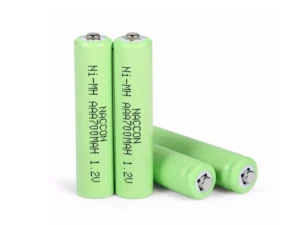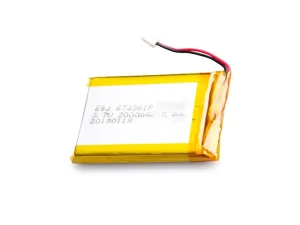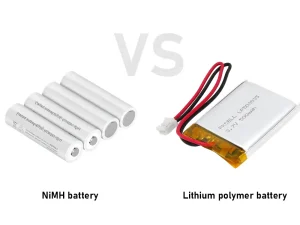When choosing batteries for your devices, you’ll notice two popular options. These are NiMH and LiPo batteries. However, before you make your selection and swipe your card at checkout, it’s essential to know the differences between the two. Each battery type has unique characteristics that make them suitable for different applications. Understanding these differences will enable you to make more informed decisions tailored to your specific needs. NiMH VS LiPo Battery, what’s the difference? This article will give you the answer.
What are NiMH Batteries?
NiMH stands for Nickel-Metal Hydride. These batteries have been around since the 1980s and represent an advancement over the older nickel-cadmium (NiCd) batteries.

NiMH batteries have a metal hydride electrode instead of cadmium. As a result, they are more environmentally friendly than their predecessors.
During charging and discharging, NiMH batteries move hydrogen ions between electrodes. They also store more energy than NiCd batteries while being safer to use. Moreover, they don’t suffer from the memory effect that plagued older battery types.
You will find NiMH batteries in everyday devices. These include flashlights, digital cameras, and remote controls. They are also available in standard sizes (AA and AAA), making them convenient replacements for disposable batteries.
Another interesting fact about NiMH batteries is worth noting. Many beginner RC car enthusiasts start with NiMH battery packs. This is because they are safer and easier to maintain, though they provide less power than LiPo batteries.
What are LiPo Batteries?
LiPo stands for Lithium Polymer. These batteries are a newer advancement in battery technology. They use lithium-ion technology but with a polymer electrolyte instead of a liquid electrolyte. This design allows them to have more flexible shapes and sizes.

LiPo batteries function by moving lithium ions between electrodes. They do this through a solid polymer electrolyte. Therefore, they can be made thinner and lighter than normal lithium-ion batteries. As a result, manufacturers can shape them into various forms to fit specific devices.
You’d normally find LiPo batteries in smartphones, tablets, and drones. And like NiMH batteries, LiPo batteries are especially popular in RC cars. They help release more power, which provides greater speed and longer run times. Their ability to deliver high currents makes them perfect for devices that require large bursts of power.
Comparison Between The NiMH VS LiPo Battery

1. Energy Density
The energy density of a battery is important. It shows the amount of power it can hold compared to its size or weight. When comparing the energy density between NiMH VS LiPo battery, the latter wins easily.
LiPo batteries can store more power (about 150 to 350 Wh/kg) in the same amount of space and weight. In contrast, NiMH batteries need to be larger and heavier to store the same amount of energy. In general, NiMH batteries have an energy density of 60-120Wh/kg, which is much lower than LiPo’s. As a result, LiPo batteries can power devices for much longer while weighing less.
The difference in energy density between a LiPo VS NiMH battery matters a lot in the devices you carry around. For instance, phone manufacturers prefer LiPo batteries because they can pack more power into smaller spaces. Similarly, drone users choose LiPo batteries so their devices can fly longer while being lightweight.
However, energy density isn’t the only factor to consider when picking out a battery.
2. Voltage
A battery’s voltage is the electrical pressure that pushes power through your device. Different types of devices need different amounts of voltage to function. Using the wrong voltage can damage your appliance beyond repair.
A LiPo battery VS NiMH battery have differing voltage levels that affect their performance in devices.
One NiMH cell gives 1.2 volts when fully charged, while one LiPo cell gives 3.7 volts at full charge. What this means is that an appliance made for one type of battery will not work with another. For example, when comparing NiMH VS LiPo battery voltage, consider this scenario. A remote control designed for four AA NiMH batteries needs 4.8 volts to function well. However, if you tried to use just one LiPo cell at 3.7 volts, the remote wouldn’t have enough power to turn on.
The voltage behavior during use also differs between these batteries.As NiMH batteries drain, there’s a steady drop from 1.2 volts down to about 1.0 volts before they’re considered dead. This means your device will work great when the battery is full but starts acting sluggish as the battery drains.
In contrast, LiPo batteries maintain a steady 3.7 volts for most of their discharge cycle before dropping quickly at the end. Therefore, devices powered by LiPo batteries work at full performance almost until the battery is completely drained.
This consistent voltage delivery makes LiPo batteries ideal for devices that need steady power. Examples include cameras or RC cars during races.
3. Discharge Rate
The discharge rate tells you how quickly a battery can release its stored energy. This measurement is important for devices that need sudden bursts of power or high performance.
LiPo batteries excel in this area because they deliver power rapidly. They can discharge at rates of 10C to 30C, meaning they can release their entire capacity in just 2–6 minutes if needed. This makes LiPo batteries ideal for gadgets like drones, electric cars, and power tools.
In contrast, NiMH batteries discharge at lower rates, typically 1C to 5C. This means they release their energy more slowly and steadily.
However, unlike LiPo batteries, NiMH batteries have their own advantages. While LiPo batteries are suitable for large power bursts, NiMH batteries are perfect for low-power applications. Examples include household devices like flashlights and cameras. These devices need a steady discharge.
The steady discharge from NiMH batteries helps them last longer. This is especially true in low-drain devices. Although they may take longer to recharge, these batteries offer consistent power over many hours of use.
4. Charge Cycles
A charge cycle represents one complete discharge and recharge of a battery.
NiMH batteries can handle more charge cycles than LiPo batteries before their capacity drops. Moreover, they’re quite forgiving if you don’t fully drain them before recharging. Partial charging does not affect their overall lifespan, which makes them very user-friendly.
In contrast, LiPo batteries last fewer charge cycles under normal conditions. However, their lifespan depends entirely on how you maintain them.
If you charge them properly and avoid deep discharges, they will last longer. Unfortunately, if you frequently overcharge your devices, you’ll have problems. The same applies if you completely drain them. Both practices will reduce the shelf life of your LiPo battery.
Interestingly, both battery types gradually lose their capacity over time, even when they are not in use. Therefore, a battery that remains unused for an extended period will have less capacity than when it was new, regardless of the number of charge cycles it has completed.
5. Memory Effect
Yes, batteries have memories. Or at least an imitation of it.
Memory effect is a phenomenon where batteries appear to “remember” partial charge cycles and lose their capacity. This is a commonly misunderstood concept, so let’s clarify how it affects the NiMH vs LiPo battery.
NiMH batteries can experience a mild memory effect, but it’s less severe than older batteries.
If you continuously charge a NiMH battery before it’s fully charged, it will lose its capacity. But that’s only temporary. To restore the battery’s full capacity, simply drain it completely and then recharge it.
Modern NiMH batteries are designed to minimize the memory effect, so you don’t have to worry about fully discharging them before every recharge. Instead, you can charge them as you normally would.
On the other hand, LiPo batteries don’t suffer from memory effects at all. This means you can charge them at any time, regardless of how much capacity is left. It’s better for LiPo batteries if you charge them frequently rather than leaving them to discharge. In addition, keeping them partially charged during storage will help maintain their lifespan.
6. Self Discharge
This refers to the speed at which a battery loses its charge when you’re not using it. A battery’s self-discharge affects how long you can store a charged battery before it needs recharging.
NiMH batteries have a relatively high self-discharge rate compared to other battery types. They lose a huge portion of their charge within weeks or months when stored at room temperature.
So, if you charge a NiMH battery and put it away, it will lose its charge after a short while.
The good news is that manufacturers have developed low self-discharge NiMH batteries to counter this problem. These special batteries are often called “pre-charged” or “ready to use” and lose their charge slowly. This makes them perfect for emergency flashlights, smoke detectors and other devices that go unused for a long time.
In comparison, LiPo batteries have much lower discharge rates. They only lose a small percentage of their charge per month when stored properly. You can charge a LiPo battery and store it for several months without significant power loss.
Nevertheless, bear in mind that temperature affects the self-discharge rate of both battery types. Higher temperatures increase self-discharge, while cooler temperatures slow it down. Therefore, you should store your batteries in a cool, dry place to help them retain their charge for longer.
Conclusion
Choosing between NiMH and LiPo batteries ultimately comes down to understanding your specific requirements. Each technology offers distinct advantages that make them suitable for different situations.
NiMH batteries are reliable, safe and cost-effective. They are ideal for everyday household devices and applications that prioritize safety.
LiPo batteries shine in high-performance applications. They are ideal for modern electronics like drones and RC vehicles.
Your decision should be based mainly on your budget and intended use so you can get the best value out of your investment.
